Kutz M. Handbook of materials selection
Подождите немного. Документ загружается.


548 PLASTICS TESTING
capable of indicating total tensile load with an accuracy of Ⳳ1% of the indicated
value or better is used. Lately, the inclination is toward using digital-type load
indicators, which are easier to read than the analog-type indicators. An extension
indicator, commonly known as the extensometer, is used to determine the dis-
tance between two designated points located within the gauge length of the test
specimen as the specimen is stretched. Figure 1 shows a commercially available
tensile testing machine. The advent of new microprocessor technology has vir-
tually eliminated time-consuming manual calculations. Stress, elongation, mod-
ulus, energy, and statistical calculations are performed automatically and
presented on a visual display or hard-copy printout at the end of the test.
1.2 Flexural Properties (ASTM D790, ISO 178)
The stress–strain behavior of polymers in flexure is of interest to a designer as
well as a polymer manufacturer. Flexural strength is the ability of the material
to withstand bending forces applied perpendicular to its longitudinal axis. The
stresses induced due to the flexural load are a combination of compressive and
tensile stresses. This effect is illustrated in Fig. 2. Flexural properties are reported
and calculated in terms of the maximum stress and strain that occur at the outside
surface of the test bar. Many polymers do not break under flexure even after a
large deflection that makes determination of the ultimate flexural strength im-
practical for many polymers. In such cases, the common practice is to report
flexural yield strength when the maximum strain in the outer fiber of the spec-
imen has reached 5%. For polymeric materials that break easily under flexural
load, the specimen is deflected until a rupture occurs in the outer fibers.
There are several advantages of flexural strength tests over tensile tests. If a
material is used in the form of a beam and if the service failure occurs in
bending, then a flexural test is more relevant for design or specification purposes
than a tensile test, which may give a strength value very different from the
calculated strength of the outer fiber in the bent beam. The flexural specimen is
comparatively easy to prepare without residual strain. The specimen alignment
is also more difficult in tensile tests. Also, the tight clamping of the test speci-
mens creates stress concentration points. One other advantage of the flexural test
is that at small strains, the actual deformations are sufficiently large to be mea-
sured accurately.
There are two basic methods that cover the determination of flexural prop-
erties of plastics. Method 1 is a three-point loading system utilizing center load-
ing on a simple supported beam. A bar of rectangular cross section rests on two
supports and is loaded by means of a loading nose midway between the supports.
The maximum axial fiber stresses occur on a line under the loading nose. A
closeup of a specimen in the testing apparatus is shown in Fig. 3. This method
is especially useful in determining flexural properties for quality control and
specification purposes.
Method 2 is a four-point loading system utilizing two load points equally
spaced from their adjacent support points, with a distance between load points
of one-third of the support span. In this method, the test bar rests on two supports
and is loaded at two points (by means of two loading noses), each an equal
distance from the adjacent support point. Method 2 is very useful in testing
materials that do not fail at the point of maximum stress under a three-point
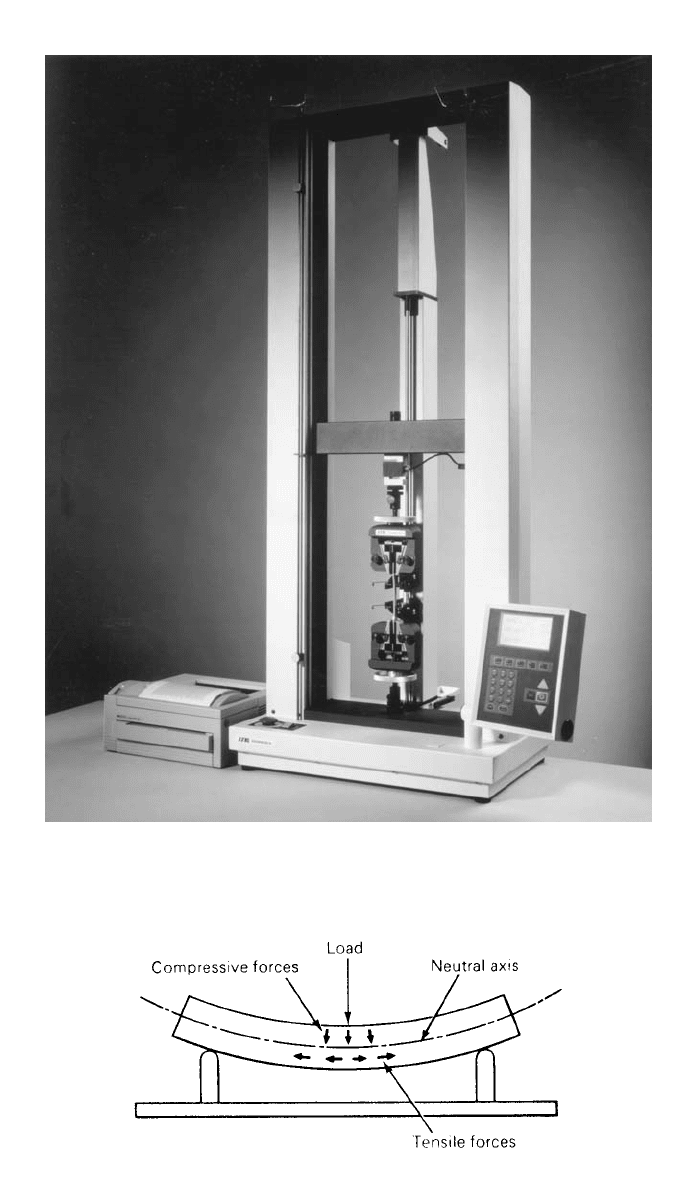
1 MECHANICAL PROPERTIES 549
Fig. 1 Tensile testing machine. (Courtesy Tinius Olsen Corporation)
Fig. 2 Forces involved in bending a simple beam. (Reprinted by permission
of McGraw-Hill Company)
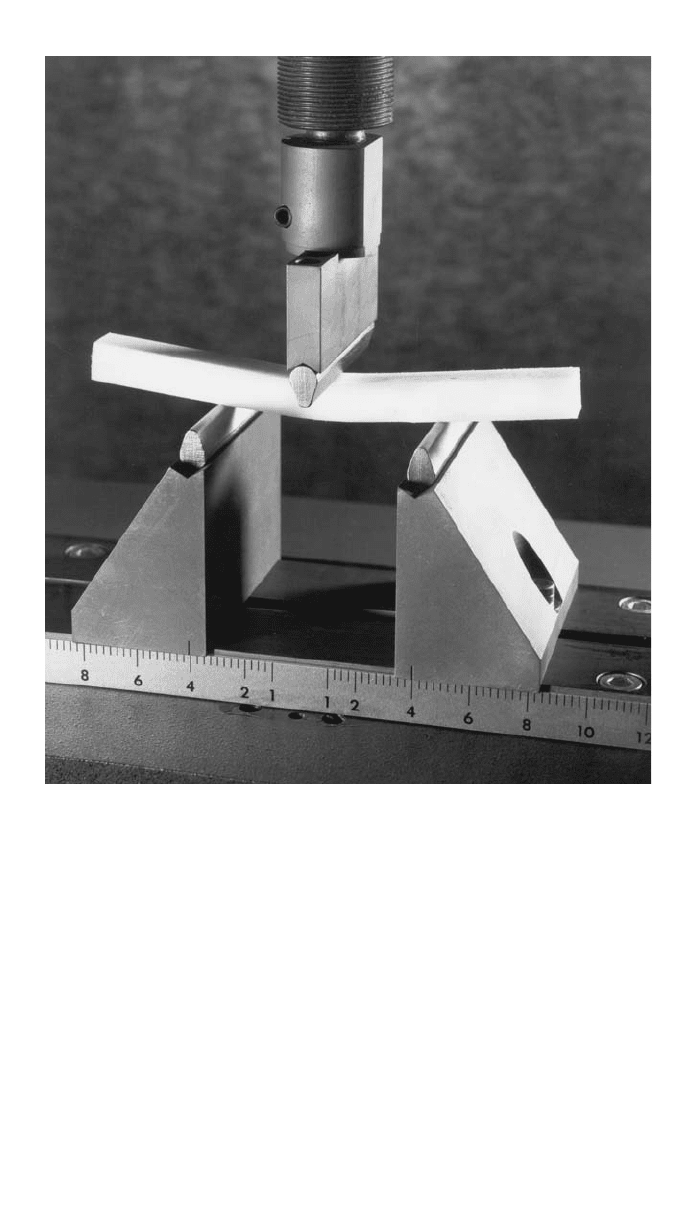
550 PLASTICS TESTING
Fig. 3 Close-up of a specimen shown in flexural testing apparatus.
(Courtesy DuPont Company)
loading system. The maximum axial fiber stress occurs on a line under the
loading nose.
Either method can be used with the two procedures. Procedure A is designed
principally for materials that break at comparatively small deflections. Procedure
B is designed particularly for those materials that undergo large deflections dur-
ing testing. The basic difference between the two procedures is the strain rate,
procedure A being 0.01 in./in./min, and procedure B being 0.10 in./in./min.
Modulus of Elasticity (Flexural Modulus)
The flexural modulus is a measure of the stiffness during the first or initial part
of the bending process. This value of the flexural modulus is, in many cases,
equal to the tensile modulus.
The flexural modulus is represented by the slope of the initial straight-line
portion of the stress–strain curve and is calculated by dividing the change in
stress by the corresponding change in strain.

1 MECHANICAL PROPERTIES 551
Fig. 4 Generalized creep curve
1.3 Creep Properties
Today, plastics are used in applications that demand high performance and ex-
treme reliability. Many components, conventionally made of metals, are now
made of plastics. The pressure is put on the design engineer to design the plastic
products more efficiently. An increasing number of designers have now recog-
nized the importance of thoroughly understanding the behavior of plastics under
long-term load and varying temperatures. Such behavior is described in terms
of creep properties.
When a plastic material is subjected to a constant load, it deforms quickly to
a strain roughly predicted by its stress–strain modulus, and then continues to
deform slowly with time indefinitely or until rupture or yielding causes failure.
This phenomenon of deformation under load with time is called creep. All plas-
tics creep to a certain extent. The degree of creep depends upon several factors,
such as type of plastic, amount of load, temperature, and time.
The short-term stress–strain data is of little practical value in actual designing
the part, since such data does not take into account the effect of long-term
loading on plastics. Creep behavior varies considerably among types of plastics;
however, under proper stress and temperature conditions, all plastics will exhibit
a characteristic type of creep behavior. One such generalized creep curve is
shown in Fig. 4. The total creep curve is divided into four continuous stages.

552 PLASTICS TESTING
The first stage (OP) represents the instantaneous elastic deformation. This initial
strain is the sum of the elastic and plastic strain. The first stage is followed by
the second stage (PQ) in which strain occurs rapidly but at a decreasing rate.
This stage, where creep rate decreases with time, is sometimes referred to as
creep or primary creep. The straight portion of the curve (QR) is characterized
by a constant rate of creep. This process is called ‘‘cold flow.’’ The final stage
(RS) is marked by increase in creep rate until the creep fracture occurs.
If the applied load is released before the creep rupture occurs, an immediate
elastic recovery, substantially equal to elastic deformation followed by a period
of slow recovery is observed. The material in most cases does not recover to
the original shape and a permanent set remains. The magnitude of the permanent
set depends upon length of time, amount of stress applied, and temperature.
The creep values are obtained by applying constant load to the test specimen
in tension, compression, or flexure and measuring the deformation as a function
of time. The values are most commonly referred to as tensile creep, compressive
creep, and flexural creep.
Tensile Creep
Tensile creep measurements are made by applying the constant load to a tensile
test specimen and measuring its extension as a function of time. The extension
measurement can be carried out several different ways. The simplest way is to
make two gauge marks on the tensile specimen and measure the distance be-
tween the marks at specified time intervals. The percent creep strain is deter-
mined by dividing the extension by initial gauge length and multiplying by 100.
The percent creep strain is plotted against time to obtain a tensile creep curve.
The tensile stress values are also determined at specified time intervals to facil-
itate plotting a stress rupture curve. The more accurate measurements require
the use of a strain gauge, which is capable of measuring and amplifying small
changes in length with time and directly plotting them on a chart paper. Figure
5 illustrates a typical setup for tensile creep testing. The test is also carried out
at different stress levels and temperatures to study their effect on tensile creep
properties.
Flexural Creep
Flexural creep measurements are also made by applying a constant load to the
standard flexural test specimen and measuring its deflection as a function of
time. A typical test setup for measuring creep in flexure is shown in Fig. 6. As
illustrated, the deflection of the specimen at midspan is measured using a dial
indicator gauge. The electrical resistance gauges may also be used in place of
a dial indicator. The deflections of the specimen are measured at a predetermined
time interval.
1.4 Stress Relaxation
Stress relaxation is defined as a gradual decrease in stress with time, under a
constant deformation (strain). This characteristic behavior of the polymers is
studied by applying a fixed amount of deformation to a specimen and measuring
the load required to maintain it as a function of time. This is in contrast to creep
measurement, where a fixed amount of load is applied to a specimen and re-
sulting deformation is measured as a function of time.
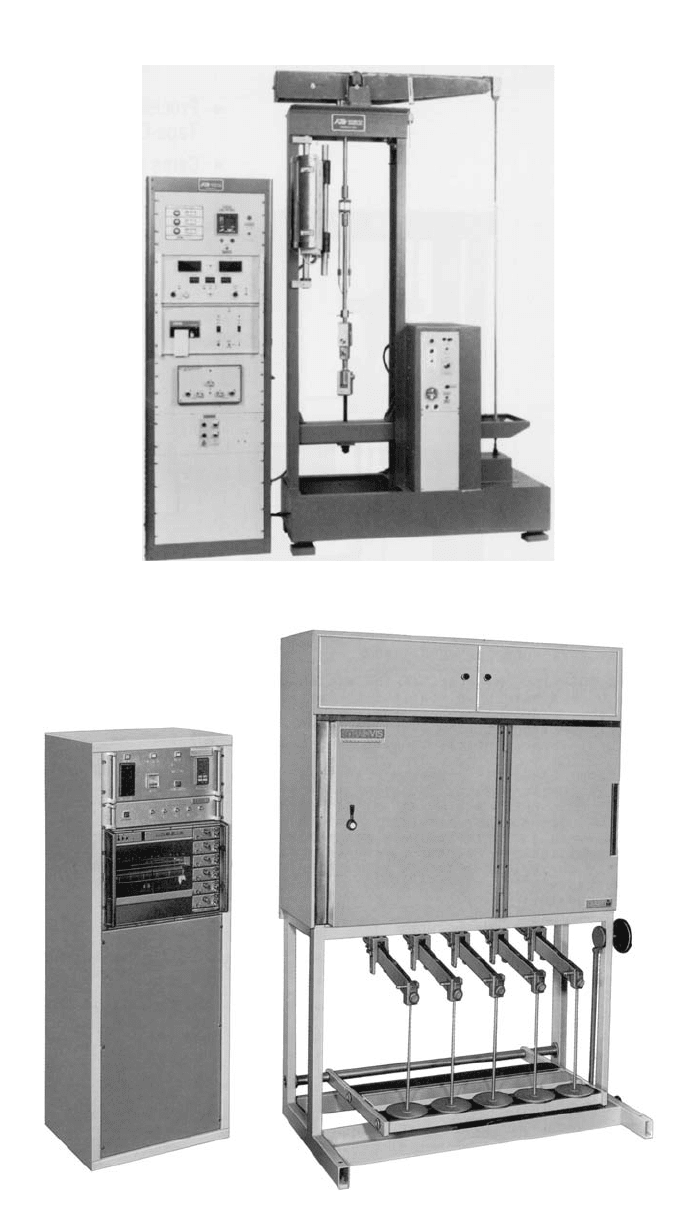
1 MECHANICAL PROPERTIES 553
Fig. 5 Typical test setup for tensile creep testing. (Courtesy Applied Test Systems Inc.)
Fig. 6 Flexural creep testing. (Courtesy Ceast U.S.A. Inc.)
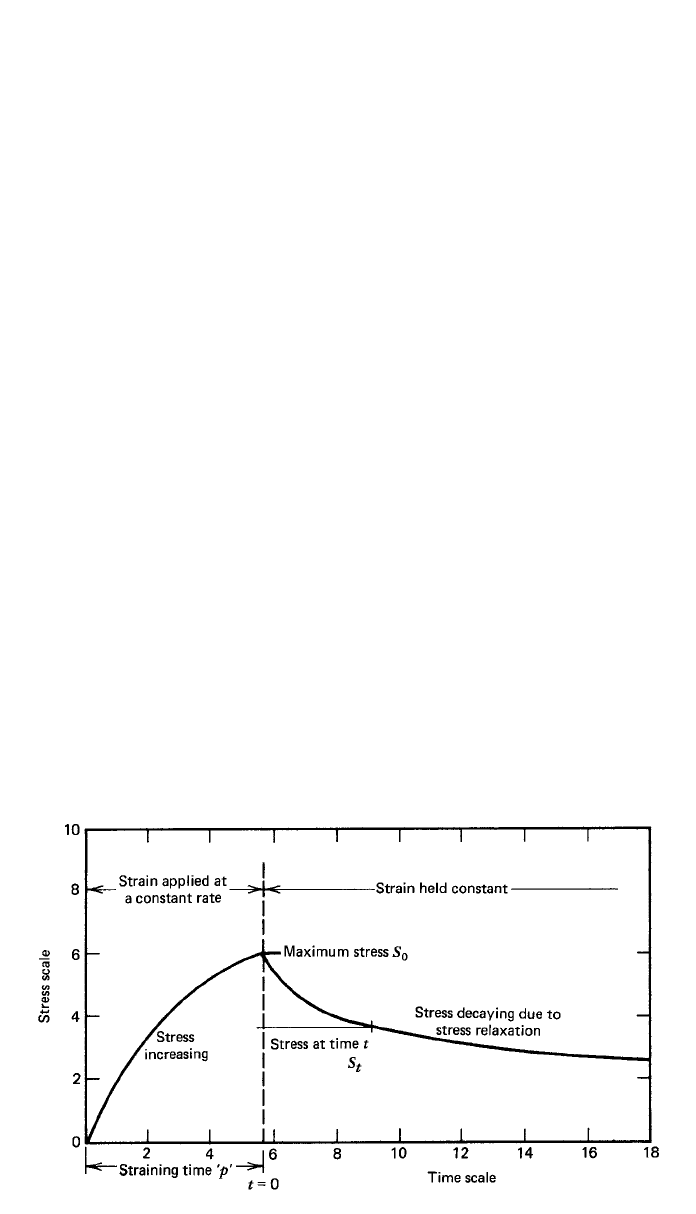
554 PLASTICS TESTING
Fig. 7 Stress–time curve. (Courtesy Instron Corporation)
Stress relaxation behavior of the polymers has been overlooked by many
design engineers and researchers, partly because the creep data is much easier
to obtain and is readily available. However, many practical applications dictate
the use of stress relaxation data. For example, extremely low-stress relaxation is
desired in the case of a threaded bottle closure, which may be under constant
strain for a long period. If the plastic material used in the closures shows an
excessive decrease in stress under this constant deformation, the closures will
eventually fail. Similar problems can be encountered with metal inserts in
molded plastics, belleville or multiple cantilever springs used in cameras, appli-
ances, and business machines.
Stress relaxation measurements can be carried out using a tensile testing ma-
chine such as that described earlier in this chapter. However, the use of such a
machine is not always practical because the stress relaxation test ties up the
machine for a long period of time. The equipment for a stress relaxation test
must be capable of measuring very small elongation accurately, even when ap-
plied at high speeds. Many sophisticated pieces of equipment now employ a
strain gauge or a differential transformer along with a chart recorder capable of
plotting stress as a function of time. A typical stress–time curve is schematically
plotted in Fig. 7. At the beginning of the experiment, the strain is applied to the
specimen at a constant rate to achieve the desired elongation. Once the specimen
reaches the desired elongation, the strain is held constant for a predetermined
amount of time. The stress decay, which occurs due to stress relaxation, is ob-
served as a function of time. If a chart recorder is not available, the stress values
at different time intervals are recorded and the results are plotted to obtain a
stress versus time curve. The stress relaxation experiment is often carried out at
various levels of temperature and strain. The stress data obtained from the stress
relaxation experiment can be converted to a more meaningful apparent modulus
data by simply dividing stress at a particular time by the applied strain. The
curve may be replotted to represent apparent modulus as a function of time. The
use of logarithmic coordinates further simplifies the stress relaxation data by

1 MECHANICAL PROPERTIES 555
allowing us to use standard extrapolation methods such as the one used in creep
experiments.
1.5 Impact Properties
The impact properties of the polymeric materials are directly related to the over-
all toughness of the material. Toughness is defined as the ability of the polymer
to absorb applied energy. The area under the stress–strain curve is directly pro-
portional to the toughness of a material. Impact strength is a measure of tough-
ness. The higher the impact strength of a material, the higher the toughness and
vice versa. Impact resistance is the ability of a material to resist breaking under
a shock loading or the ability to resist the fracture under stress applied at high
speed.
The theory behind toughness and brittleness of the polymers is very complex
and therefore difficult to understand. The molecular flexibility plays an important
role in determining the relative brittleness or toughness of the material. For
example, in stiff polymers such as polystyrene and acrylics, the molecular seg-
ments are unable to disentangle and respond to the rapid application of me-
chanical stress and the impact produces brittle failure. In contrast, flexible
polymers such as plasticized vinyls have high-impact strength due to the ability
of the large segments of molecules to disentangle and respond rapidly to me-
chanical stress.
Impact properties of the polymers are often modified simply by adding an
impact modifier such as butadiene rubber or certain acrylic compounds. The
addition of a plasticizer also improves the impact strength at the cost of rigidity.
Material such as nylon, which has relatively fair impact strength, can be oriented
by aligning the polymer chains to improve the impact strength substantially.
Another way to improve the impact strength is to use fibrous fillers that appear
to act as stress transfer agents.
Most polymers, when subjected to the impact loading, seem to fracture in a
characteristic fashion. The crack is initiated on a polymer surface due to the
impact loading. The energy to initiate such a crack is called the crack initiation
energy. If the load exceeds the crack initiation energy, the crack continues to
propagate. A complete failure occurs when the load has exceeded the crack
propagation energy. Thus, both crack initiation and crack propagation contribute
to the measured impact strength. There are basically four types of failures en-
countered due to the impact load.
Brittle Fracture. In this type of failure the part fractures extensively without
yielding. A catastrophic mechanical failure such as the one in the case of
general-purpose polystyrene is observed.
Slight Cracking. The part shows evidence of slight cracking and yielding
without losing its shape or integrity.
Yielding. The part actually yields showing obvious deformation and stress
whitening but no cracking takes place.
Ductile Failure. This type of failure is characterized by a definite yielding of
material along with cracking. Polycarbonate is considered a ductile mate-
rial.
The distinction between the four types of failures is not very clear and some
overlapping is quite possible.
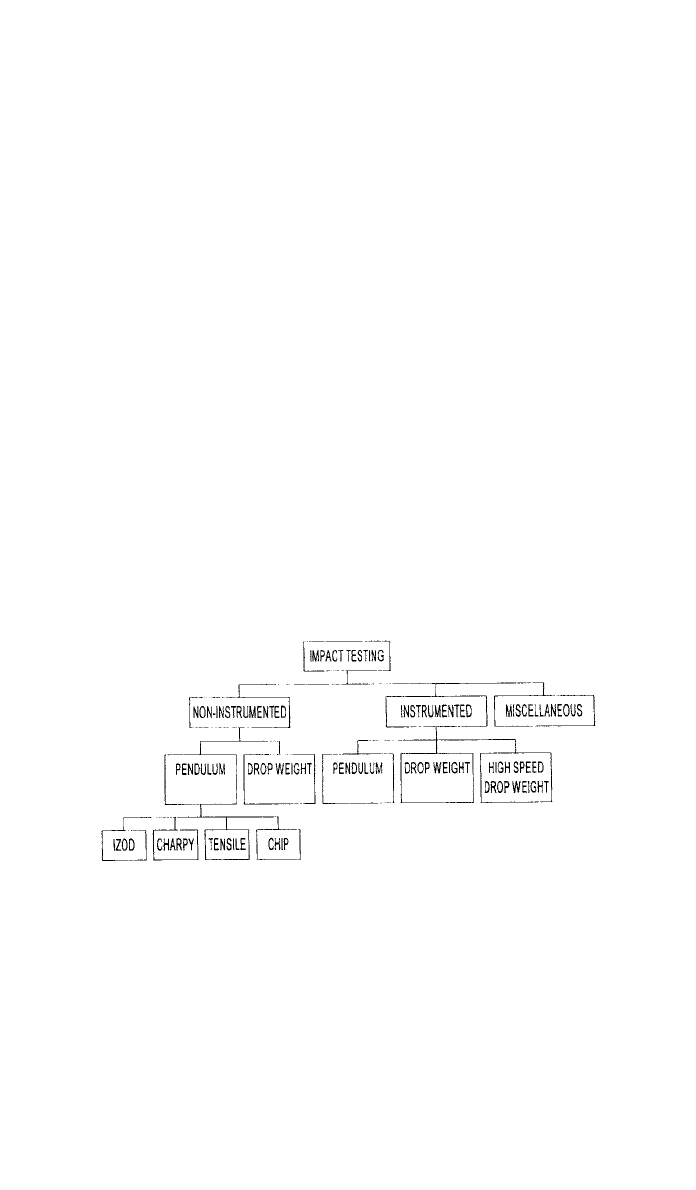
556 PLASTICS TESTING
Impact strength is one of the most widely specified mechanical properties of
the polymeric materials. However, it is also one of the least understood prop-
erties. Predicting the impact resistance of plastics still remains one of the most
troublesome areas of product design. One of the problems with some earlier
Izod and Charpy impact tests was that the tests were adopted by the plastic
industry from metallurgists. The principles of impact mechanisms as applied to
metals do not seem to work satisfactorily with plastics because of the plastics’
complex structure.
Types of Impact Tests
In the 1980s and 1990s, a tremendous amount of time and money have been
spent on research and development of various types of impact tests by organi-
zations throughout the world. Attempts have been made to develop different
sizes and shapes of specimens as well as impact testers. The specimens have
been subjected to a variety of impact loads including tensile, compression, bend-
ing, and torsion impacts. Impact load has been applied using everything from a
hammer, punches, and pendulums to falling balls and bullets. Unfortunately, very
little correlation exists, if any, between the types of tests developed so far. Nu-
merous technical papers and articles have been written on the subject of the
advantages of one method over the other. To this date, no industrywide consensus
exists regarding an ideal impact test method. In this chapter, an attempt is made
to discuss as many types of impact tests as possible along with the respective
advantages and limitations of each test. Impact testing is divided into three major
classes and subdivided into several classes as follows:
Pendulum Impact Test: IZOD–CHARPY (ASTM D-256, ISO 179). The
objective of the Izod–Charpy impact test is to measure the relative susceptibility
of a standard test specimen to the pendulum-type impact load. The results are
expressed in terms of kinetic energy consumed by the pendulum in order to
break the specimen. The energy required to break a standard specimen is actually
the sum of energies needed to deform it, to initiate its fracture, and to propagate
the fracture across it, and the energy expended in tossing the broken ends of the
specimen. This is called the toss factor. The energy lost through the friction and
vibration of the apparatus is minimal for all practical purposes and usually ne-
glected.
The specimen used in Izod test must be notched. The reason for notching the
specimen is to provide a stress concentration area that promotes a brittle rather
than a ductile failure. A plastic deformation is prevented by such type of notch

1 MECHANICAL PROPERTIES 557
in the specimen. The impact values are seriously affected because of the notch
sensitivity of certain types of plastic materials.
The Izod test requires a specimen to be clamped vertically as a cantilever
beam. The specimen is struck by a swing of a pendulum released from a fixed
distance from the specimen clamp. A similar setup is used for the Charpy test
except for the positioning of the specimen. In the Charpy method, the specimen
is supported horizontally as a simple beam and fractured by a blow delivered in
the middle by the pendulum. The obvious advantage of the Charpy test over the
Izod test is that the specimen does not have to be clamped and, therefore, it is
free of variations in clamping pressures.
Apparatus and Test Specimens. The testing machine consists of a heavy base
with a vise for clamping the specimen in place during the test. In most cases,
the vise is designed so that the specimen can be clamped vertically for the Izod
test or positioned horizontally for the Charpy test without making any changes.
A pendulum-type hammer with an antifriction bearing is used. Additional
weights may be attached to the hammer for breaking tougher specimens. The
pendulum is connected to a pointer and a dial mechanism that indicates the
excess energy remaining in a pendulum after breaking the specimen. The dial
is calibrated to read the impact values directly in in.-lb or ft-lb. A hardened steel
striking nose is attached to the pendulum. The Izod and Charpy tests use dif-
ferent types of striking noses. A detailed list of requirements is discussed in the
ASTM standards book. Figure 8 illustrates a typical pendulum-type impact test-
ing machine. The test specimens can be prepared either by molding or cutting
them from a sheet. Izod test specimens are 2
⫻⫻in. size. The most
111
–––
228
common specimen thickness is but in. is preferred since it is less sus-
11
––
-in.
84
ceptible to bending and crushing. A notch is cut into a specimen very carefully
by a milling machine or a lathe. The recommended notch depth is 0.100-in.
Test Procedures
Izod Test. The test specimen is clamped into position so that the notched
end of the specimen is facing the striking edge of the pendulum. The pendulum
hammer is released, allowed to strike the specimen, and swing through. If the
specimen does not break, more weights are attached to the hammer and the test
is repeated until failure is observed. The impact values are read directly in
in.-lbf or ft-lbf from the scale. The impact strength is calculated by dividing
the impact values obtained from the scale by the thickness of the specimen. For
example, if a reading of 2 ft-lbf is obtained using an -in.-thick specimen, the
1
–
8
impact value would be 16 ft-lbf/in. of notch. The impact values are always
calculated on the basis of 1-in.-thick specimens even though much thinner spec-
imens are usually used. The reversed notched impact strength is obtained by
reversing the position of a notched specimen in the vise. In this case, the notch
is subjected to compressive rather than tensile stresses during impact. As dis-
cussed earlier in this chapter, the energy required to break a specimen is the
sum of the energies needed to deform it, initiate and propagate the fracture, and
toss the broken end (toss factor).
Falling-Weight Impact Test. The falling-weight impact test, also known as
the drop impact test or the variable-height impact test, employs a falling weight.
This falling weight may be a tup with a conical nose, a ball, or a ball-end dart.
